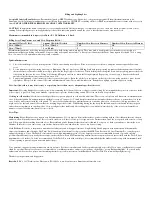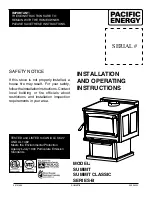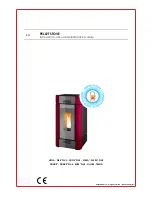
Brasslite Stove Instructions - Brasslite Turbo F
Before using your Brasslite stove please be sure to completely read and understand terms of use, disclaimer, warranty and instructions described below. By
using the stove, you agree to the terms of use, the disclaimer and the warranty. If you have questions, please directly contact the manufacturer listed at the
end of the instructions.
TERMS OF USE/CAUTIONS:
This stove is intended for cooking while backpacking or camping outdoors. It is NOT intended for use as a space heater. It is NOT intended for interior use such as
inside a house, apartment, trailer or any other enclosed domicile.
NEVER
use this stove inside a tent or under a low-hanging vestibule or tarp, due to fire danger.
Oxygen depletion and carbon monoxide poisoning may also be the result of using this stove in any confined space, causing injury or death. Use common sense.
BE SAFE, NOT SORRY.
WARNING:
This stove is intended for use with
alcohol ONLY. NEVER
use Coleman Fuel (white gas), gasoline, acetone, laquer thinner or a similarly volatile liquid
inside this or any other alcohol stove. Using such fuels will almost certainly result in a large flare-up which may create a hazardous fire condition.
DO NOT OVER-FILL THE STOVE.
The stove has a recommended maximum fuel capacity of 1 US fluid ounce (30 ml). Over-filling the stove will cause fuel to
spill out of the side ports. If alcohol is seen spilling from the holes prior to lighting the preheat fuel, the stove is definitely overfilled. Do not light the stove. Pour the
alcohol from the stove back into the fuel bottle and measure again.
CAUTION:
In daylight the flame of an alcohol stove is virtually invisible. Unlike a white-gas or compressed-gas stove, there is no hissing sound to assure you it's
running. When lighting the stove in daylight it helps to have the windscreen partially around the stove so that the flame can be seen more easily.
NEVER
attempt to light this stove if the stove is in any position other than sitting upright on its base.
NEVER
add fuel to the stove while it’s still lit. Make sure that all
flame is extinguished before adding fuel. Adding fuel while the stove is lit may result in a hazardous fire.
DISCLAIMER
Backpacking involves serious dangers such as (but not limited to) injury, death, impairment of one's self or others, damage or destruction of property, and emotional
trauma. All backpacking stoves create a potentially hazardous condition for the user. Seller assumes no responsibility for the condition and operation of this stove by
buyer. Buyer assumes all responsibility for the use of this stove. Buyer assumes all risk of loss and injury and warrants that he or she will defend, indemnify and hold
seller harmless. Buyer represents that no reliance is made upon any act or conduct of the seller.
WARRANTY
The stove has been tested to safely support a weight up to 20 lbs. (9 kg.) without deforming. If a full cook pot is placed forcefully or dropped onto the stove, a force
many times the weight of the pot is created and this may result in deformity of the stove chamber. The stove may also deform if dropped, stepped on, or stored loosely
in a backpack. It is intended that it be stored inside a cook pot or other container. This stove is constructed of thin sheet metal and it must be handled with care. With
proper care this stove will last for many years. This stove was tested at the time of manufacture and was in good working order at the time of shipping. It is warranted
to be free from structural defects for as long as the original buyer owns the stove. "Structural defects" refers specifically to voids or breaks in welds, solder seams and/or
wall surfaces that rarely develop during normal use. In the rare case of a bona fide structural defect, seller agrees to pay the cost of return shipping charges and provide
a new stove at no additional charge. Punctures, dents or other deformities that occur during use do not constitute structural defects. It is not recommended that the stove
be operated in other than original condition and therefore seller makes no offer to repair any damages inflicted by buyer. No other warranty either express or implied is
offered.
STOVE RETURN POLICY
A stove may be used for up to 30 days and returned without explanation, provided that it is undamaged. Damage includes dents, deep scratches and other blemishes that
cannot be removed with cleaning agents. Discoloration/oxidation of the metal during firing is normal and does not constitute damage. At Brasslite's discretion there may
be a $10 fee to cover the time and materials of cleaning a returned stove. Shipping charges are not refundable. An additional fee of $2 is applied if the stove was
purchased using PayPal, since those fees are not refunded to Brasslite. In the event that a stove is returned, cleaned, and damage is discovered, the customer is required
to keep the stove and must pay for the cleaning fee and return postage. Decisions made by Brasslite are final. After 30 days, stoves are not returnable.
Instructions for making the Brasslite Windscreen
Important Note:
Your stove does not include a windscreen. This simple but time-consuming step has been omitted in order to keep stove labor costs down. Also, pots
come in different sizes and accurate cutting according to your pot size saves more weight than a “fits all” windscreen. The instructions are easy to follow.
Materials:
12” wide heavy duty aluminum foil (purchase from any grocery store), paper clips (optional). Alternatively, aluminum oven liner can be used, which is
thicker and more durable. If you use oven liner, use a single layer cut to the dimensions listed below (instead of folding it over itself to make it thicker, like you would
do with the aluminum foil).
Tools needed:
Yardstick or tape measure, permanent black marker (a sharpie works well for this), scissors, standard office paper hole punch.
1.
Measure the pot you intend to use by wrapping a tape measure around the widest point, or alternatively, wrap a piece of string around the pot and measure the
length of it. Add 6 inches to the measurement. Unroll twice this amount of foil from the container, plus a little extra. You can always trim later if needed.
2.
With dull side facing up, fold the foil widthwise so that it’s 12” high, and “X” number of inches long. Smooth foil flat.
3.
Fold the foil lengthwise in half to obtain a strip that is 6” high, and “X” number of inches long. Smooth foil flat. The piece is now four layers thick.
4.
Fold loose long side over ¼ inch to reinforce it, then fold again. With this fold facing up, wrap foil around pot under the handle while the pot is sitting on the
stove, and check to see that there is 2 inch overlap of the ends, with the correct 0.5” gap between windscreen and pot. Trim foil as needed with scissors to get the
correct overlap. Fold cut end over ¼ inch to reinforce it.
5.
Using the paper punch, and starting 1inch from the end, cut holes at 1inch intervals ½ inch above the bottom of the windscreen to within 1inch of the other end.
This allows proper airflow during cooking.
If you have a pot that uses a pot gripper, trimming angles at the corners opposite the holes is not necessary. If your pot has permanently attached handles it’s necessary
to adjust the ends so that the windscreen will sit closely enough to the pot with the handles protruding out. Fold the corners of the screen down at a 45 degree angle and
gradually increase the size of the fold until the windscreen sits with the proper overlap, there is the recommended gap of 1/2” between cook pot and windscreen and it
doesn’t interfere with the handles. If there is a lot of extra material in the folds when done, trim the excess material as needed.
To assure proper stove operation it’s important to make sure that the windscreen is not wrapped too closely to the stove during firing. A minimum gap of 0.5
inches (1.25 cm) is critical for airflow and proper stove operation. Wrapping the windscreen too tightly may cause the stove to overheat, resulting in flaring
and rapid consumption of the fuel. Use the largest possible opening according to the limitations of wind conditions.




















